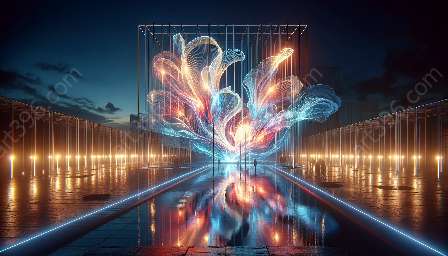Light art, as a form of artistic expression, raises various ethical considerations in its creation, presentation, and reception. To fully comprehend these ethical considerations, we must first understand the science behind light art and its impact on the art world.
The Science Behind Light Art
Light art is a medium that uses light as its primary component to create artistic expression. The science behind light art involves the technical understanding of how light behaves, its interaction with different surfaces, and its manipulation to create visual experiences.
Artists often work with different light sources, such as LED lights, neon lights, and projection mapping, to illuminate and transform spaces. They also consider the properties of light, such as color, intensity, and direction, to convey their artistic vision.
Light Art and Its Impact
Light art has transformed the art world by offering a new dimension of visual and immersive experiences. It challenges traditional artistic practices and provides a dynamic platform for contemporary artists to engage with audiences in unconventional ways.
Furthermore, light art has the potential to redefine the boundaries of creativity and expression, offering endless possibilities for artistic innovation. This transformative impact has sparked conversations about the ethical implications of using light as a medium in art.
Ethical Considerations in Using Light as a Medium in Art
When exploring the ethical considerations in using light as a medium in art, several key aspects come into focus:
- Environmental Impact: The production and use of artificial light sources in light art raise concerns about energy consumption and environmental sustainability. Artists must consider the ecological footprint of their installations and the responsible use of light resources.
- Public Space and Accessibility: Light art often interacts with public spaces, raising questions about public accessibility and inclusivity. Artists must navigate the balance between artistic intervention and the public's right to the urban environment.
- Perception and Well-being: The visual intensity and sensory effects of light art installations may impact viewers' perception and well-being. Artists should consider the potential discomfort or overstimulation caused by their creations, especially in public settings.
- Intellectual Property and Copyright: As technology plays a significant role in light art, artists must navigate the ethical considerations related to intellectual property and copyright. This includes the use of digital mapping, interactive technologies, and the appropriation of existing light-based artwork.
- Representation and Cultural Appropriation: The content and themes depicted in light art raise ethical questions about representation and cultural appropriation. Artists must critically examine their use of cultural references and symbols to avoid misrepresentation and exploitation.
Conclusion
Light art presents a unique intersection of artistic expression, scientific understanding, and ethical considerations. As the art world continues to evolve, understanding and addressing the ethical implications of using light as a medium in art are essential for artists, curators, and audiences to engage in thought-provoking and responsible artistic experiences.

